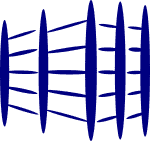What are the ways for us to profile the inventory to ensure the storage type used is correct?
A community for warehouse and logistics discussion. Allows like-minded practitioners to interact by sharing ideas and knowledge in the forum.
To begin with, we can look at how the orders are dropped.
1. Whether the orders are full pallets, partial pallets, cartons or loose.
2. Whether if the majority is single line/order or multiple lines/order.
3. What time the orders are dropped and when they need to be fulfilled.
Can we also look into the dimension, weight, and type of inventory?
Is this also a type of inventory profiling?
Some companies classify the goods in terms of the cost prices as well.
The inventory profile is intended for the implementation of and accounting for movements and on-hand inventory as they are related to a kind of activity. The kind of activity defines the way that the item was received by the organization and the restrictions that are imposed on the handling of the item. Here are some examples of kinds of activity:
1. The purchase of the item on the agreement for further sales or processing
2. The receipt of items under a commission agreement
3. The receipt of raw material for processing
In all these cases, the movements and on-hand inventory of the same item that is received by the organization as a result of different kinds of activity should differ in the following aspects:
1. Inventory management – Quantitative on-hand inventory of the item for different kinds of activity should not be mixed.
2. Accounting – Movements and on-hand inventory of the item for different kinds of activity should be reflected in different ledger accounts.
The inventory profiles functionality lets you perform these tasks:
1. Set up inventory dimensions in accordance with the organization's kinds of activity. For more information, see the Kinds of activity section.
2. Use the inventory profile as an inventory dimension. For more information, see the Inventory profile as an inventory dimension section.
3. Set up compatible inventory profiles. For more information, see the Compatible inventory profiles section.
4. Set up and use inventory posting ledger accounts in the context of inventory profiles. For more information, see the Inventory transaction combinations for inventory profiles section.
5. Specify an inventory profile when you set up the inventory posting. For more information, see the Inventory posting setup section.
6. Set up a default inventory profile and a default kind of activity for purchase orders, sales orders, and transfer orders. For more information, see the Set up a kind of activity and an inventory profile in purchase, sales, and transfer orders section.
7. Split sales order lines by inventory profile. For more information, see the Split sales order lines by inventory profile section.
8. Specify the inventory profile on bill of materials (BOM) lines. For more information, see the Inventory profile in BOMs section.
9. Specify the inventory profile in the cash flow forecast on purchase orders and sales orders. For more information, see the Cash flow forecasts on purchase and sales orders section.
10. Specify the inventory profile in cash flow forecasts that are based on planned purchases and sales. For more information, see the Cash flow forecasts based on planned purchases and sales section.

